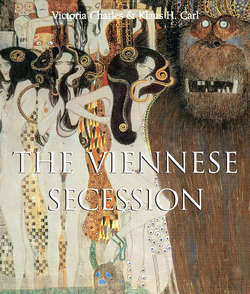Читать книгу The Viennese Secession - Victoria Charles - Страница 4
На сайте Литреса книга снята с продажи.
Vienna in the Second Half of the 19th Century
The World Fair of 1889
ОглавлениеThe multiple artistic trends that would lay the foundation for a new holistic style of art should manifest themselves on the Paris World Fair of 1889 first. The English exhibitors showcased their very own taste in furniture. The American silversmiths Graham and Augustus Tiffany decorated the products of their workshops with fascinating new ornaments while Louis Comfort Tiffany (1848–1933) showed the products of his revolutionary technique for the creation of stained glass.
An elite group of French artists exhibited individual pieces that also marked a progress in the spreading of the popularity of applied art in France. Émile Gallé (1846–1904) put furniture and coloured vases of his own design on display while Clément Massier (1845–1917), Albert Dammouse (1848–1926), and Auguste Delaherche (1857–1940) could convince the visitors of the world fair with mottled earthenware in hitherto rarely used brilliant colours and daring shapes. Henri Vever (1875–1932), The House of Boucheron, and Lucien Falize (1839–1897) presented intricately designed jewellery and silverware. The new trend towards elegant and capillary-thin ornaments was technically advanced to such a high degree that Falize even presented commonplace silverware with complex herbal designs.
The new ideas that were presented at the World Fair soon blossomed: everyone pushed towards a revolution in art. They sought liberation from the ideals and prejudice of the so-called ‘exalted’ art, and thus artists all over Europe began searching for new forms of artistic expression. In 1891, the Societé Nationale des Beaux-Arts created a new department for applied art, which was initially not held in very high esteem but at least managed to participate in the Salon with pewterware by Jules Desbois (1851–1935), Alexandre Charpentier (1856–1909), and Jean Baffier (1851–1920). In 1895, the rising popularity of applied art forced the Société des Artistes Français to accept the creation of a department solely dedicated to this newly revived branch for the annual Salon exhibitions. Later that year, the Hamburg-born Siegfried Bing (1838–1905), after returning from an assignment in the United States, opened a shop which he called “Art Nouveau”.
Henri Vever, Vase with Crickets.
Bronze and enamelled silver.
Exhibited in the Salon of the National Society of Fine Arts in 1904 in Paris. Robert Zehil collection.
Edward Burne-Jones and Kate Faulkner (design) and John Broadwood (production), Grand piano, 1883.
Oak, stained and decorated with gold and silver-gilt gesso, 266 × 140.5 × 45.7 cm.
Victoria and Albert Museum, London.
William Morris, Tapestry.
Émile Gallé, Vitrine with Artistic Vases.
Marquetry and glass.
Macklowe Gallery, New York.
Eugène Grasset, Salon des cent, 1894.
Print for a colour poster.
Victor and Gretha Arwas collection.
Walter Crane, Swans, wallpaper design, 1875.
Gouache and watercolour, 53.1 × 53 cm.
Victoria and Albert Museum, London.
